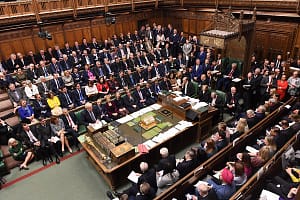Today, Thursday October 19th, is the 36th anniversary of what became known as ‘Black Monday’. On this day in 1987 stock markets around the world crashed.
The Dow Jones fell 22.6% in one day and London’s FTSE 100 shed one fifth of its value over two days. Newspapers and television were full of pictures of traders in panic.
Reflecting on 1987 is interesting in its own right, plus whether there are lessons for today.
The 1987 crash demonstrated many influences. Equity markets had previously risen sharply, partly reflecting that credit conditions were too loose, with markets seen as being out of touch with economic reality. Macro-economic worries were reflected in concern over the twin US trade and budget deficits and worries about the dollar.
Poor US trade figures on the preceding Thursday had spooked the markets, which had been worried already by a small interest rate hike by Germany a week earlier. That rate rise had confirmed that global policy coordination was at an end.
We had just witnessed the golden era of global policy coordination, from September 1985 to the summer of 1987. The August 1985 Plaza and spring 1987 Louvre accords marked a time when the G7 acted impressively together to first weaken and then stabilise the dollar.
Interestingly, the London market had been closed the Friday before Black Monday, because of the great storm that hit the south-east of England in the early hours of October 16th, although that didn’t change the course of events.
The crash led to fears of a depression and prompted central banks to pump liquidity into the economy and to cut interest rates. The Bank of England base rate was 10% on Black Monday and reached a low of 7.5% the following May. At the time, I wrote in The Times and other papers of the problems to come, and said rates would double. A year later, in October 1989, base rate was up to 15%. The Lawson Boom then became a bust.
Today, financial markets are being impacted by a different set of worries.
One might argue that bond markets have already had their crash as yields have risen sharply in recent years. Equity markets, too, are not in the same position as in 1987 and have already been impacted by the steady recent rise in both policy rates and bond yields. Also, there is regular comment now that UK assets look undervalued by international comparisons.
Nonetheless, the combination of monetary policy tightening and geopolitics are currently weighing on equities and markets more generally now. Monetary policy has been covered here in detail before so let’s focus on geopolitics.
A potentially dominant influence
In particular, geopolitical risk has reared its head as a potentially dominant influence on financial markets in coming months. That doesn’t mean markets will crash but it points to greater uncertainty and potentially increased volatility.
Geopolitics, as well as domestic politics, is always present as an influence, albeit perhaps not always directly. But there are times, as has been the case with the war in Ukraine, when geopolitics has a more influential role. This looks set to be the same now given events in the Middle East.
Markets do not react to all wars, particularly if they are between smaller countries or are seen as having limited contagion. The recent Armenia-Azerbaijan conflict is just one of many such examples.
There are a number of hotspots across the globe in terms of geopolitical problems and risks which have the potential to trigger economic or financial market contagion and market reaction. Geopolitical hotspots might fit into a number of categories.
Not all impacts might be sudden. Some might be drawn out, taking time for the full picture to be seen, even if the initial trigger itself is horrific and causes an immediate flight to quality.
The most serious are those that lead to fears of a paradigm shift. 9/11 was one, leading to a war on terror. There is much conjecture that October 7th and subsequent developments could be the same.
Thus the present focus in financial markets on a flight to quality – although this has not been as significant as one might have expected, perhaps in part because there is now greater uncertainty about what constitutes a safe-asset. Nowadays such a flight tends to favour the dollar, although that was not always the case and certainly wasn’t back in 1987.
Also, the natural safe haven is usually bonds and sometimes gold, but bonds have suffered for three years. Gold has performed well in recent years and although it is expensive and its latest reaction has been muted, it may still find support from ongoing risks.
Geopolitical risk can come in other guises
Occasionally domestic upheaval or significant political events in one of the major powers might be included here, such as a change of leadership or even the empowerment of a current incumbent. The latter was the case last autumn in China, the former might be the case next autumn in the US. This impact of these on the markets can often be more drawn out, as there is a focus on how policy evolves.
The global backdrop currently is changing. In political terms it might be seen as a G3 world: the US and its allies; China and its allies; and the non-aligned group spearheaded by India. In economic and financial terms it might be the early stages of a two-tier world.
When geopolitical tensions escalate, all these factors need consideration. Already, in recent years there has been a shift in the global economy away from globalisation to fragmentation of trade, with on-shoring as production returns home and friend-shoring, where geopolitical allies source from each other. This reflects a shift in supply chains away from primarily reducing costs, to minimising risks.
Last week, on the sidelines of the IMF and World Bank meetings, the director general of the WTO, Dr Ngozi Okonjo-Iweala, reiterated a call she has made before, for re-globalisation of global trade.
Two of the key words she used were ‘inclusive’ and ‘diversify’. This is the crux of the worry for the world economy as a result of geopolitics, namely trade and financial flows divide into distinct camps, based on geopolitics. This would dent global growth prospects, with growth in future years perhaps less than it might otherwise have been.
Already in the wake of the pandemic, the bifurcation of the world economy has become an increased risk. This has been reinforced by a move in the US towards large subsidies underpinned by a domestic industrial policy and in China towards self-sufficiency in key areas like technology.
It is, though, still more of a perceived than an actual risk in many sectors of the world economy, particularly those that have nothing to do with security or defence. And it hasn’t yet impacted global finance as much as might have been feared at the start of the Russia-Ukraine war.
Indeed, the last two years have raised doubts about the ability of the west to ensure trade and financial sanctions bite. Also, reinforcing the need to keep risks in context, markets have been encouraged that despite geopolitical tensions, there have been four high-level visits of US officials to China in recent months, namely the US Commerce Secretary, Secretary of State, Treasury Secretary and the Climate Envoy.
Other aspects
There are other ways that geopolitics may impact markets. Sometimes, geopolitical risks can be concentrated in regional hotspots. Always worrying for markets are geopolitical risks that involve the major powers and which have the potential to escalate. Tensions surrounding Taiwan have been seen in such a light and it is quite possible that even if events in the Middle East now do not trigger a paradigm shift, as noted above, they could lead to escalating regional contagion.
Events that impact economically important areas are always of concern for markets as this usually ensures high economic contagion, with examples being food production or energy output. The current War in Ukraine might fit both of these categories.
The impact from the current conflict in the Middle East has been to give oil prices a boost, although they had been weaker recently because of global economic slowdown. A regional military escalation and tighter sanctions on exports of Iranian oil are talked about openly as factors that could instil a higher risk premium for oil prices. It is difficult to say whether this would push oil prices much higher, but it would keep them higher than they would otherwise be.
Choke points and supply
Geopolitical issues could also impact some of the so-called “choke points” of the world economy which are so important for global trade and supply chains. These choke points include the Strait of Hormuz and the Suez Canal, which could yet be impacted by an escalation of regional tensions in the Middle East, particularly the Strait of Hormuz.
Other choke points are not seen as being at risk to such geopolitical risks including the Malacca Straits near Singapore (through which one quarter of global trade and one-third of seaborne oil passes), the Panama Canal, the Strait of Gibraltar (never a problem in modern times) and the Turkish Straits (more important since tensions with Russia escalated).
Choke points have the potential to disrupt supply-chains, and become a potentially wider issue when seen in terms of the over-dependence of the world economy on certain countries for the production of key commodities or components. China’s near monopoly on the production of rare earths has been an issue now for over two decades.
Also, the so-called chip wars of last year highlighted additional concentration risks in their production. Currently it is the combined impact of the War in Ukraine and events in the Middle East to impact energy markets that is an immediate challenge for the world economy.
Finally
In conclusion, the anniversary of any major event like the 1987 crash is often a time to reflect on the lessons. While markets are not in the same position as then, it is always necessary to be mindful of risks. These continue to evolve. By 2008 it was a global financial crisis. By 2020 it was a global health crisis. We are not in a current crisis, but economies are more vulnerable and the policy room for manoeuvre limited, hence markets are increasingly sensitive to risks.
The UK, like Western European economies, was hit hard by the contagion from the War in Ukraine, at a time when inflation pressures were already acute. Now economic risks are on the downside, with the economy susceptible to additional shocks that dent confidence or which push oil prices higher. Currently the main scenario is for the UK to grow at a weak pace and to avoid recession. The challenge to this is not only monetary policy overkill but contagion from rising geopolitical tensions





Leave a Comment